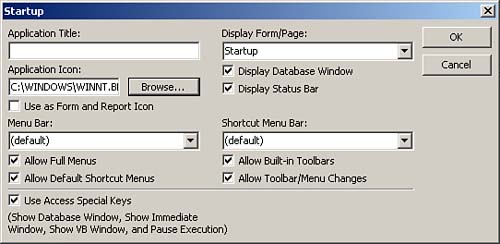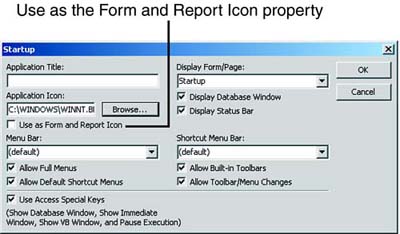Setting Startup Options
Access provides several startup options that enable you to control what happens to an application when it is loaded. Figure 24.15 shows the Startup dialog box, and Table 24.1 lists each option in the Startup dialog box.
Figure 24.15. The Startup dialog box.

Option | Function |
|---|---|
Application Title | Sets the AppTitle property, which displays a custom title in the application title bar. |
Application Icon | Sets the AppIcon property, which displays a custom icon in the application title bar. |
Menu Bar | Sets the StartupMenuBar property, which specifies the custom menu bar displayed by default when the application is loaded. |
Allow Full Menus | Sets the AllowFullMenus property, which allows or restricts the use of Access menus. |
Allow Default Shortcut Menus | Sets the AllowShortcutMenus property, which allows or restricts the use of standard Access shortcut menus (that is, menus accessed with a right-click). |
Display Form/Page | Sets the StartupForm property, which specifies the form displayed when the application is loaded. |
Display Database Window | Sets the StartupShowDBWindow property, which determines whether the Database window is visible when the application is opened. |
Display Status Bar | Sets the StartupShowStatusBar property, which determines whether the status bar is visible when the application is opened. |
Shortcut Menu Bar | Sets the StartupShortcutMenuBar property, which specifies that a menu bar should be displayed by default as the shortcut (that is, right-click) menu bar. |
Allow Built-in Toolbars | Sets the AllowBuiltInToolbars property, which indicates whether built-in toolbars are available to users. |
Allow Toolbar/Menu Changes | Sets the AllowToolbarChanges property, which determines whether users can customize toolbars in the application. |
Use Access Special Keys | Sets the AllowSpecialKeys property, which determines whether users can use keys such as F11 to display the Database window, Ctrl+F11 to toggle between custom and built-in toolbars, and so on. |
Notice that the Use as Form and Report Icon option that is grayed out in Figure 24.15 is available when you designate an application icon (see Figure 24.16). When you check this option, Access uses the icon you designate as the application icon as the icon for forms and reports. Figure 24.16. Using the application icon for forms and reports.
|
As you might have guessed, many of the options in the Startup dialog box apply only when you are running the application under the full version of Access (as opposed to the runtime version). You do not need to set the Display Database Window option, for example, if the application will be running only under the runtime version of Access. The Database window is never available under the runtime version of Access, so Access ignores this property when the application is run under the runtime version. Nevertheless, I like to set these properties to ensure that the application behaves as I want it to under both the retail and runtime versions of Access.
Only users with Administer permission for the database can modify the Startup dialog box options. If you want to ensure that certain users cannot modify these options of the database, you must make sure that they do not have Administer permission. |








